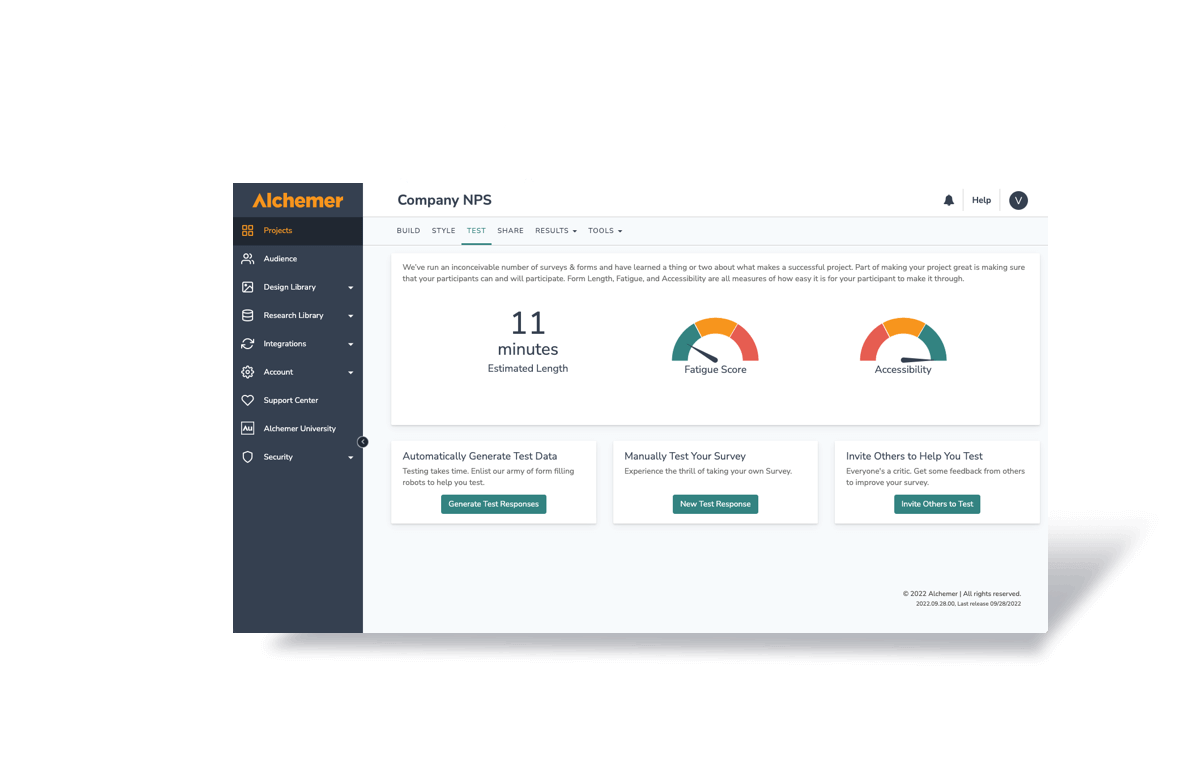“I had an 80% survey response rate! What response rate did you get?” In the world of surveys, response rates often serve as a badge of honor. Although response rate is not the sole determinant of survey effectiveness, achieving a high response rate is definitely advantageous.
It contributes to the credibility of your findings and can enhance the overall quality of the data collected. Therefore, focusing on strategies to improve your survey response rates is important for obtaining meaningful insights.
It’s important to recognize that elevated response rates often correlate with excellent survey design. Strong survey design is a key factor in achieving success in any survey initiative. By prioritizing thoughtful design, you can significantly enhance the effectiveness of your surveys.
Increasing your survey response rate is not merely about hitting a numerical target. It’s about gathering meaningful insights that can drive actionable decisions. Research indicates that two primary motivations drive individuals to participate in surveys:
- They believe their feedback will influence something important to them.
- They want to share their opinions with someone who values their input.
While incentives can encourage participation, relying on them can sometimes feel misplaced. Understanding these motivations is essential for crafting surveys that resonate with respondents. Here are ten effective strategies for improving your survey response rates:
1. Design Your Survey with the Respondent in Mind
A high response rate starts with a well-designed survey that prioritizes the respondent’s experience. A respondent-friendly survey shows that you respect their time and input.
Make sure the survey is visually appealing, easy to navigate, and logical in flow. Use clear language and avoid jargon, ensuring that each question is straightforward and easy to understand. Incorporating user-friendly features, such as progress bars or clear instructions, can further enhance the overall experience.
2. Eliminate “Nice-to-Know” Questions
When designing your survey, it’s vital to distinguish between “need-to-know” and “nice-to-know” questions. While the latter may yield interesting insights, they often do not lead to actionable outcomes. Including unnecessary questions can frustrate respondents and lead to survey abandonment.
Focus on gathering information that will directly inform your decisions. Be sure to respect your respondents’ time by keeping your survey concise and purposeful. This approach will enhance the overall experience and encourage participation.
3. Prepare the Respondent
Effective communication sets the stage for successful participation. Clearly articulate the purpose of your survey, estimate the time commitment, and explain how you will use the data.
Transparency fosters trust, making respondents feel valued. Additionally, let them know if you plan to follow up with non-respondents. This signals that their feedback is genuinely important to you. A well-prepared respondent is more likely to complete your survey.
4. Know Your Audience
Understanding your target audience is critical for effective survey design. Tailor your questions and language to resonate with the specific demographic you’re targeting.
Take the time to research their preferences, interests, and pain points. The more relevant your survey feels to them, the more likely they will participate. Utilize segmentation to create surveys that speak directly to the unique characteristics of your audience.
5. Personalize Your Survey Invitations
When sending out survey invitations, personalization can significantly impact response rates. Use recipients’ names and personalize the content to reflect their specific experiences or demographics. Sending invitations from a recognizable figure—someone the respondent respects or trusts—can also enhance engagement. Personal touches make respondents feel valued and appreciated, increasing their likelihood of participation.
6. Have a Live Person at the Other End of Your Survey
Providing a human touch can go a long way in boosting response rates. Make sure that all replies to email invitations go to a live person. This person should be able to respond promptly to any questions or concerns.
For paper surveys, include a phone number where respondents can reach out for assistance. When respondents know they can communicate with a real person, it alleviates concerns and encourages participation.
7. Put Your Most Important Questions First
Capturing the respondent’s attention right from the start is crucial. Begin your survey with the most important questions that directly relate to your research objectives. Avoid starting with demographic questions, as they can be off-putting. By engaging respondents with relevant questions early on, you increase the chances of them completing the survey.
8. Use Multiple Reminders
Persistence pays off when it comes to survey participation. Implement a systematic approach to follow up with non-respondents. Sending gentle reminders through various channels, such as email, SMS, or social media, demonstrates that you value their participation. It also conveys that you consider their input important.
This approach can encourage respondents to engage with your survey. However, be mindful of the frequency of these reminders; too many can lead to annoyance and potentially discourage participation.
9. Use Sampling When Appropriate
Respect for your respondents’ time should be a priority. If you can achieve the same level of insight with 250 responses as you would with 500, opt for sampling. This approach not only shows consideration for respondents’ time but also allows for more efficient data collection. By utilizing representative samples, you can still draw meaningful conclusions without burdening a larger audience.
10. Act on the Information Received and Share Results with Participants
Demonstrating that you value respondents’ feedback is a powerful way to enhance future survey participation. When respondents see that their input leads to real changes, they are more likely to participate in future surveys. This commitment to acting on feedback fosters trust and encourages ongoing engagement.
After collecting data, clearly communicate the actions you will take based on the survey results. When participants see tangible outcomes stemming from their input, they are more likely to engage in future surveys. Sharing results fosters a sense of community and reinforces the idea that respondents’ opinions matter.
Additional Strategies to Consider
Beyond these ten primary strategies, there are several additional techniques you can employ to further enhance your survey response rates:
11. Optimize for Mobile
With an increasing number of respondents accessing surveys via mobile devices, optimizing your survey for mobile use is essential. Ensure that your survey is responsive, meaning it adjusts seamlessly to different screen sizes. Mobile-friendly surveys are easier to complete on-the-go, resulting in higher participation rates.
12. Utilize Engaging Formats
Consider using engaging question formats to make the survey experience more interactive. Options like sliders, rating scales, and visual elements can enhance participant engagement. These formats encourage respondents to interact with the survey in a more dynamic way. Engaging formats can keep respondents interested and encourage them to complete the survey.
13. Create a Sense of Urgency
Introducing a sense of urgency can motivate respondents to participate quickly. Use phrases like “limited-time survey” or “respond by [specific date]” to create a timeline that encourages action.
14. Offer Incentives Wisely
While incentives can boost response rates, it’s important to approach them thoughtfully. Align your incentives with your audience’s interests and ensure that they perceive them as valuable to encourage participation. Incentives like gift cards or exclusive content can effectively encourage participation in your survey.
However, it’s crucial to ensure that these incentives feel genuine. When they enhance the survey experience rather than detract from it, they can significantly boost engagement.
15. Pilot Test Your Survey
Before launching your survey to a broader audience, conduct a pilot test with a small group. This allows you to identify any potential issues in question clarity, survey flow, or technical functionality. Gathering feedback from the pilot group can help you make necessary adjustments to improve the overall respondent experience.
16. Be Respectful of Privacy
In an era where data privacy is paramount, ensuring respondents’ confidentiality is crucial. Clearly outline how you will use, store, and protect their data. Building trust around privacy concerns can enhance respondents’ willingness to share their opinions.
Conclusion
Boosting your survey response rate is a multifaceted process. It involves understanding your audience and designing a thoughtful survey. Additionally, fostering a sense of community around feedback can significantly enhance participation.
By implementing these strategies, you can create a more engaging survey experience, encouraging respondents to share their valuable insights. High response rates are not just about the numbers. They reflect the effectiveness of your survey design. Additionally, they demonstrate your commitment to valuing respondents’ opinions.
Remember, a well-designed survey does more than just capture responses. It also helps build a lasting relationship with participants. This foundation paves the way for meaningful engagement in future research initiatives.
The next time you hear someone boast about their survey response rate, you can confidently join the conversation. You ground your approach to enhancing participation in thoughtful, strategic practices. This knowledge empowers you to engage meaningfully in discussions about survey effectiveness.
By focusing on how to improve your survey response rate, you position your organization for success. This approach enables you to gather critical insights necessary for informed decision-making. Utilizing these strategies will ultimately increase your response rates. This improvement ensures that your surveys yield the meaningful data you need to drive progress.




